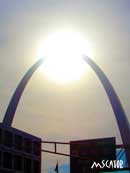"(I wanted to) to create a monument which would have lasting significance and would be a landmark of our time...at the edge of the Mississippi River, a great arch did seem right." ~ Eero Saarinen
Oh, soaring beauty of lasting significance! On this day in 1965, at the edge of the Mississippi, the final section was placed into St. Louis, Missouri's Gateway Arch.
As part of the Thomas Jefferson National Expansion Memorial, the monument celebrates the 6 million acres of the Louisiana Purchase, Lewis and Clark, and America's Westward expansion.
"Nature presents to the view of the traveler vast," observed explorer Meriwether Lewis. "Walls of tolerable workmanship, so perfect...that I should have thought that nature had attempted here to rival the human art of masonry."
The arch certainly rivals nature's beauty. The tallest man-made monument in the U.S. with a height and base width of 630 feet, the graceful tapered catenary curve sweeps the sky with shining stainless-steel passion.
This gleaming arch was designed by Finnish-American architect Eero Saarinen (1910-1961) and chosen from 172 entries.
"The purpose of architecture is to shelter and enhance manís life on earth and to fulfill his belief in the nobility of his existence," Saarinen said.
At a cost of more than $13 million, the engineering marvel took over two years to build. Its 142-welded triangular pieces and 60-foot foundations were constructed to withstand high winds and earthquakes. The Arch has become the internationally recognizable symbol of St. Louis.
A ride on one of two unique internal trams provides visitors with a panoramic view of the city. On a clear day the view at the top can extend up to thirty miles in either direction.
"The only architecture which interests me is architecture as fine art. That is what I want to pursue. I hope some of my buildings will have lasting truths. I admit frankly that I would like a place in architectural history," said Saarinen.
 Let your creativity arch the horizon.
Let your creativity arch the horizon.
